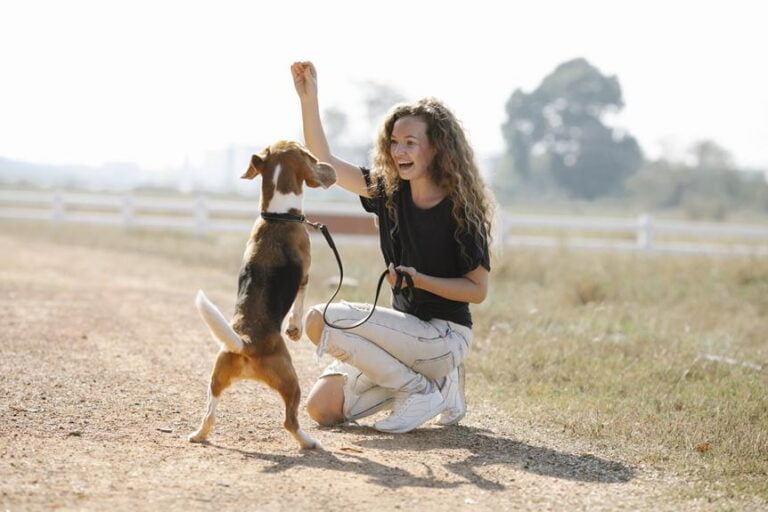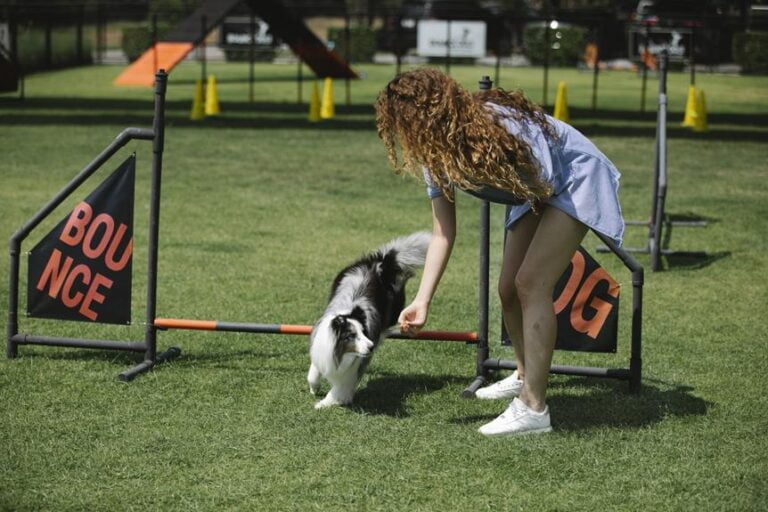Positive Obedience Training for Dogs – An Ultimate Guide
Are you tired of your dog’s unruly behavior? Look no further! This ultimate guide to positive obedience training for dogs is here to save the day.
Packed with expert tips and techniques, this comprehensive guide will transform your furry friend into a well-behaved companion.
From understanding positive reinforcement to addressing behavior issues, this guide covers it all.
Get ready to build a strong bond with your dog and enjoy a harmonious relationship like never before.
Key Takeaways
- Positive reinforcement is an effective training technique that rewards desired behaviours and builds a strong bond between dog and trainer.
- Consistency in cues, commands, and body language helps dogs understand what is expected and establishes clear communication.
- Teaching basic commands, such as ‘sit,’ ‘stay,’ and ‘lie down,’ using positive reinforcement techniques is essential for obedience training.
- Identifying the root cause of behaviour issues and using positive reinforcement techniques can help address and resolve these issues, with professional help if needed.
Understanding Positive Reinforcement
Understanding positive reinforcement is essential for effective obedience training in dogs. Positive reinforcement is a training technique that focuses on rewarding desired behaviours to encourage their repetition. It involves providing something pleasant or desirable to the dog immediately after they exhibit the desired behaviour. This could be in the form of treats, praise, or playtime.
The principle behind positive reinforcement is simple: dogs learn through association. By associating a reward with a specific behaviour, the dog is more likely to repeat that behaviour in the future. This technique is based on the understanding that dogs are motivated by rewards and seek to avoid punishment.
Positive reinforcement has several advantages over other training methods. Firstly, it creates a positive and enjoyable learning experience for the dog, fostering a strong bond between the dog and the trainer. Secondly, it helps to build the dog’s confidence and self-esteem as they are constantly being rewarded for their efforts. Lastly, positive reinforcement is more effective in producing long-lasting behavioural changes compared to punishment-based techniques.
To successfully implement positive reinforcement, it is important to choose the right rewards that are highly motivating for the dog. These rewards should be given immediately after the desired behaviour to reinforce the association. Consistency is also key, as the dog needs to understand that the reward is directly linked to their behaviour.
Establishing Clear Communication
Clear communication is essential for effective obedience training in dogs. When establishing clear communication with your furry friend, consider the following:
- Consistency: Dogs thrive on routine and consistency. Use the same cues and commands consistently to avoid confusion and reinforce their understanding of what is expected.
- Body language: Dogs are highly observant of human body language. Use clear and deliberate gestures to accompany verbal commands, making it easier for them to comprehend your instructions.
- Tone of voice: Dogs are sensitive to tone and can pick up on subtle changes in your voice. Use a firm and confident tone when giving commands to convey authority and clarity.
- Timing: Dogs associate consequences with their behaviour based on timing. Deliver rewards or corrections promptly, ensuring that they understand the connection between their actions and the outcome.
By implementing these communication techniques, you can establish a strong foundation for obedience training.
Remember to be patient and consistent, allowing your dog to learn at their own pace. With clear communication, you can effectively communicate your expectations and build a strong bond of trust and understanding with your furry companion.
Teaching Basic Commands
To effectively train your dog in obedience, it is crucial to begin teaching them basic commands. Basic commands are the foundation for more advanced training and help establish clear communication between you and your furry friend. When teaching basic commands, it is important to use positive reinforcement techniques to encourage your dog’s cooperation and build a strong bond.
The first command you should teach your dog is ‘sit.’ This command is relatively easy to teach and can be used in various situations, such as when you want your dog to stay still or when greeting guests. Start by holding a treat close to your dog’s nose and slowly move it upwards, causing their head to tilt back. As their head goes up, their bottom will naturally go down into a sitting position. Once they are sitting, reward them with the treat and praise.
Another essential command to teach your dog is ‘stay.’ This command is especially useful in situations where you need your dog to remain in one place, such as when you open the front door or when there are distractions around. To teach this command, have your dog sit and then hold your hand up in front of their face, palm facing them, and say ‘Stay.’ Step back a few steps and then return to your dog, rewarding them with a treat and praise for staying in place.
The third basic command to teach your dog is ‘lie down.’ This command is useful for getting your dog to settle down or when you want them to be in a calm position. Start by having your dog sit, then hold a treat close to their nose and slowly move it towards the ground. As your dog follows the treat, their body will naturally lower into a lying position. Once they are lying down, reward them with the treat and praise.
Addressing Behavior Issues
When addressing behaviour issues during positive obedience training for dogs, it is important to identify and address any problematic behaviours that may arise. Here are some key points to consider:
- Understanding the root cause: Determining why the dog is displaying the behavior is essential. Is it due to fear, anxiety, or lack of socialisation? Identifying the underlying cause will help in developing an effective training plan.
- Positive reinforcement: Utilizing positive reinforcement techniques is crucial when addressing behaviour issues. Rewarding desired behaviours encourages the dog to repeat them while punishing or scolding only creates fear and confusion.
- Consistency: Consistency is vital in addressing behaviour issues. Dogs thrive on routine and predictability, so maintaining a consistent training approach will help them understand what is expected of them.
- Seeking professional help: In some cases, behaviour issues may require the assistance of a professional dog trainer or behaviourist. They have the knowledge and expertise to develop a tailored training plan and provide guidance throughout the process.
By following these steps, dog owners can effectively address and correct behaviour issues during positive obedience training.
Building a Strong Bond With Your Dog
Continuing the exploration of positive obedience training for dogs, the next step is to foster a deep and meaningful connection with your canine companion. Building a strong bond with your dog is essential for effective training and overall well-being. When you establish a strong connection, your dog will be more attentive, responsive, and eager to please.
One effective way to build this bond is through regular quality time and positive reinforcement. Spend dedicated time each day engaging in activities that your dog enjoys, such as playing fetch, going for walks, or simply cuddling. This will Positive Obedience Training and strengthen the bond between you and your furry friend.
Another powerful tool to strengthen your connection is the use of a rewards system. By rewarding desired behaviours with treats, praise, or affection, you are reinforcing the bond and encouraging your dog to continue behaving positively. Positive reinforcement is a key component of building trust and loyalty.
To further illustrate the importance of a strong bond, consider the following table:
| Benefits of a Strong Bond | Emotional Impact |
|---|---|
| Increased trust | Feelings of security and safety |
| Enhanced communication | Sense of understanding and connection |
| Improved obedience | Confidence and satisfaction |
| Greater loyalty | Deepened sense of companionship |
Frequently Asked Questions
What Are Some Common Mistakes Dog Owners Make When Using Positive Reinforcement in Obedience Training?
When using positive reinforcement in obedience training, dog owners commonly make mistakes that hinder their training progress. Some of these mistakes include inconsistency in rewarding desired behaviours, using punishment or aversive methods alongside positive reinforcement, over-reliance on treats instead of other rewards, and not providing clear and consistent cues or commands.
It is important for dog owners to be aware of these common mistakes and to seek guidance from a professional dog trainer to ensure effective and positive training outcomes.
How Can I Prevent My Dog From Becoming Bored or Disinterested During Training Sessions?
To prevent your dog from becoming bored or disinterested during training sessions, it is important to keep the sessions engaging and varied. Incorporate different types of rewards, such as treats, praise, or playtime, to maintain their interest.
Break the training into short, focused sessions to prevent fatigue. Use positive reinforcement techniques, such as clicker training or shaping, to keep the training positive and enjoyable for your dog.
Additionally, make sure to choose a training environment that is free from distractions and conducive to learning.
Are There Any Specific Breeds That May Require Different Approaches to Positive Obedience Training?
Certain breeds of dogs may require different approaches to positive obedience training due to their unique characteristics and traits. These variations can affect their learning abilities, attention spans, and motivation levels.
By understanding the specific needs of each breed, trainers can tailor their training methods and techniques to effectively engage and motivate these dogs.
This personalised approach ensures that the training sessions are both enjoyable and effective, resulting in a well-behaved and obedient dog.
What Should I Do if My Dog Doesn’t Respond to Positive Reinforcement Methods?
If your dog does not respond to positive reinforcement methods, it is important to first assess the situation and identify any potential underlying issues.
It could be that the training techniques need to be adjusted or modified to better suit your dog’s individual needs and temperament.
In some cases, seeking the assistance of a professional dog trainer or behaviourist may be necessary to address any behavioural challenges and provide guidance on alternative training approaches.
Can Positive Obedience Training Be Effective for Older Dogs or Rescues With Previous Behavioral Issues?
Positive obedience training can be effective for older dogs or rescues with previous behavioural issues, like a ray of sunlight breaking through the clouds. By using positive reinforcement techniques, such as rewards and praise, trainers can help these dogs overcome their past experiences and develop new, desired behaviours.
It is important to approach training with patience, consistency, and understanding, tailoring the methods to suit the individual dog’s needs. With time and dedication, positive obedience training can lead to remarkable transformations in these dogs’ behaviour and overall well-being.
Conclusion
In conclusion, positive obedience training is a crucial aspect of building a strong bond with your dog and addressing behaviour issues.
By using positive reinforcement techniques and establishing clear communication, you can effectively teach your dog basic commands and address any behaviour issues that may arise.
This training not only improves your dog’s behaviour but also strengthens the bond between you and your furry companion.
Remember, a well-trained and obedient dog is a happy and fulfilling addition to any family.







